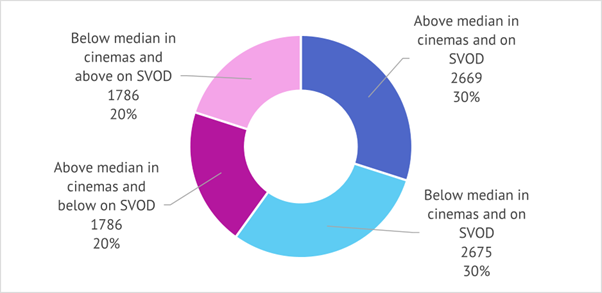Download The impact of cinema admissions on SVOD usage here
Background to this report
The first edition of a new report “The impact of cinema admissions on SVOD usage” has just been published by the European Audiovisual Observatory, part of the Council of Europe in Strasbourg.
This report analyses the relationship between SVOD viewing and cinema admissions in 9 European Union countries.
Main findings by comparing film consumption in cinemas and on SVOD
-
EU-produced films have a higher share of overall cinema admissions (28%) than their share of SVOD consumption (22%). This lower share on SVOD is due to the comparatively lower performance of EU national films, while EU non-national films tend to perform better on SVOD than in cinemas.
- Films are much more dependent on their national markets in cinemas (84% of admissions) than on SVOD (62% of viewings). This observation applies to all countries in the sample, except Germany, where the share of non-domestic cinema admissions and of SVOD viewing is similar.
- Whatever the origin of the films, the films with the highest number of admissions in cinemas account for a comparatively larger share of total cinema admissions than the films most widely viewed on SVOD out of total SVOD viewing. This is probably due to a much larger number of films available on SVOD.
Main findings concerning the correlation between film consumption in cinemas and on SVOD
Excellent performance in cinemas does not automatically mean excellent performance on SVOD:
- Most of the top 100 titles by cinema admissions since 1996 are available on SVOD. However, less than 20% of them are among the top 100 most watched films on SVOD.
- Top EU blockbusters available since 1996 are even less likely to be among the most watched EU films on SVOD: fewer EU films are available on SVOD, and when they are available, they barely make it into the top 20.
- Films released theatrically in a country overperform on SVOD compared with films that did not get a theatrical release. Across all the countries in the sample, theatrically released films account for 46% of films on SVOD but 57% of viewing time. The ‘premium’ for theatrical releases is particularly high in Sweden and Denmark.
- 60% of films performed similarly in cinemas and on SVOD, i.e. either below the median in both in cinemas and on SVOD, or above the median in both cinemas and on SVOD.
- Conversely, only a limited number of films performed better on SVOD than in cinemas: 20% of films of all origins performed below the median in cinemas but above the median on SVOD.
ALL-ORIGIN TITLES: Share of titles above and below cinema admissions median and median of viewing time on SVOD
In % and number of titles, films produced in 1996 or later, all origins, both cinema releases and SVOD, EU9

Time period of the data:
- The retained time frame for SVOD is from 1 September 2022 to 1 September 2023.
- The retained time frame for cinema admissions is:
- For Part 1 (comparison between cinema admissions and SVOD consumption) from 1 January 2022 to 31 December 2022.
- For Part 2 (correlation between cinema admissions and SVOD consumption) from 1996 to 2023.

